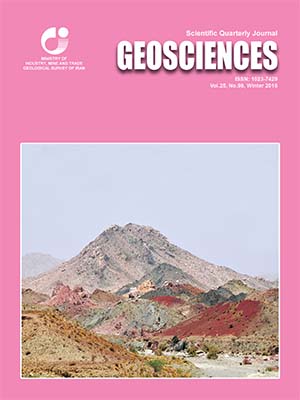Document Type : Original Research Paper
Authors
1 Associate Professor, Department of Geology, Lorestan University, Khoramabad, Iran
2 Ph. D. Student, Department of Geology, Lorestan University, Khoramabad, Iran
3 Ph. D., Geological Survey of Iran, Tehran, Iran
4 M.Sc., Geological Survey of Iran, Tehran, Iran
Abstract
Lohneh gold and copper deposits lay in the north west of Iran, 100 kilometers north of Zanjan province. Lohneh mining area is a part of the Tarommetallogenic zone in the Alborz-Azerbaijan region. The presence of numerous minerals, slag melting of mining activities (such as cows and exploratory pits, tunnels) in the Armenian fortress (by Armenian miners) shows that the mineral reserve Lohneh have been considered by old miners. There are 9 gold bearing quartz veins .Two main quartz vein with a length of 500 meters and a width of one meter (visible on the Earth). Rock outcrops in the area consist of the Eocene-Oligocene volcanic rocks (tuffs, tuff breccia, trachyandesite) and intrusive rocks (granodiorite, quartz monzonite, monzonite). On the basis of geochemistry study, intrusive rocks is resemble the I-Type granitoids and from a magmatic stand point, the rocks of the area are calc–alkaline, and tectonically they belong to the continental margin and subduction zones. Tuff breccia rocks cut by quartz monzonite and has been altered. The major alteration of the areas consists of silicious, sericitic, and argillic alteration. The main gold minerals have occurred in tuff breccia rocks and a small amount of gold mineral in quartz monzonite. Gold mineralization in the Lohneh area is in the form of open space, vein-veinlet and hydrothermal breccia. According to chemical analysis of gold mineralized samples gold grade is in the range of at least 0.002 to 10ppm. The average gold grade is 4.35ppm. Mineralogy of Lohneh deposit has a metallic minerals (oxide, sulfide) and non-metallic (silicate and carbonate) which is composed of two phases hypogene and supergene. Metallic minerals are including gold particles (free in siliceous gangue and visible under a microscope and SEM study), silver (in the free form in siliceous and involved in galena and tetrahedrite network), pyrite, chalcopyrite, bornite, galena, sphalerite, and tetrahedrite. Non-metallic minerals or gangue consist of quartz, hydrothermal alkali feldspar (adularia), sericite, clay minerals, calcite, and small amount of barite. According to geochemical studies (table correlation of elements, graph clustering and component plot in rotated space) gold with Ag(0.78), cu(0.81), As(0.7), Pb(0.64), Zn(0.6), S(0.4), Bi(0.45), U(0.3), Mo(0.25) is a significant correlation. This correlation geochemistry is corresponded with mineralography evidence (mineral paragenesis sequence) and SEM studies. Fluid inclusion study was performed on primary, large size and rich liquid fluid inclusions on quartz mineral (concurrent with the formation of gold and sulfide minerals).Fluid inclusion data shows in the temperature range from 125 to 290 °C and salinity between 1 and 6.5 wt% NaCl and depths less than 1000 m. Fluid inclusion evidence shows cooling effect, boiling and formation of solutions with high salinity and density of the ore forming fluids in Lohneh deposits. Adularia mineral, calcite, bladed and comb quartz and hydrothermal breccia are evidence of boiling effect in the Lohneh deposits.Evidence of the presence of epithermal textures (banded, comb, blade, and hydrothermal breccia), sericitic alteration, and sulfide minerals such as galena, sphalerite, chalcopyrite, tetrahedrite, and fluid inclusions evidence (temperature, salinity, density, vapor-rich inclusions) indicates intermediate sulphidation epithermal gold deposits in Lohneh area.
Keywords

